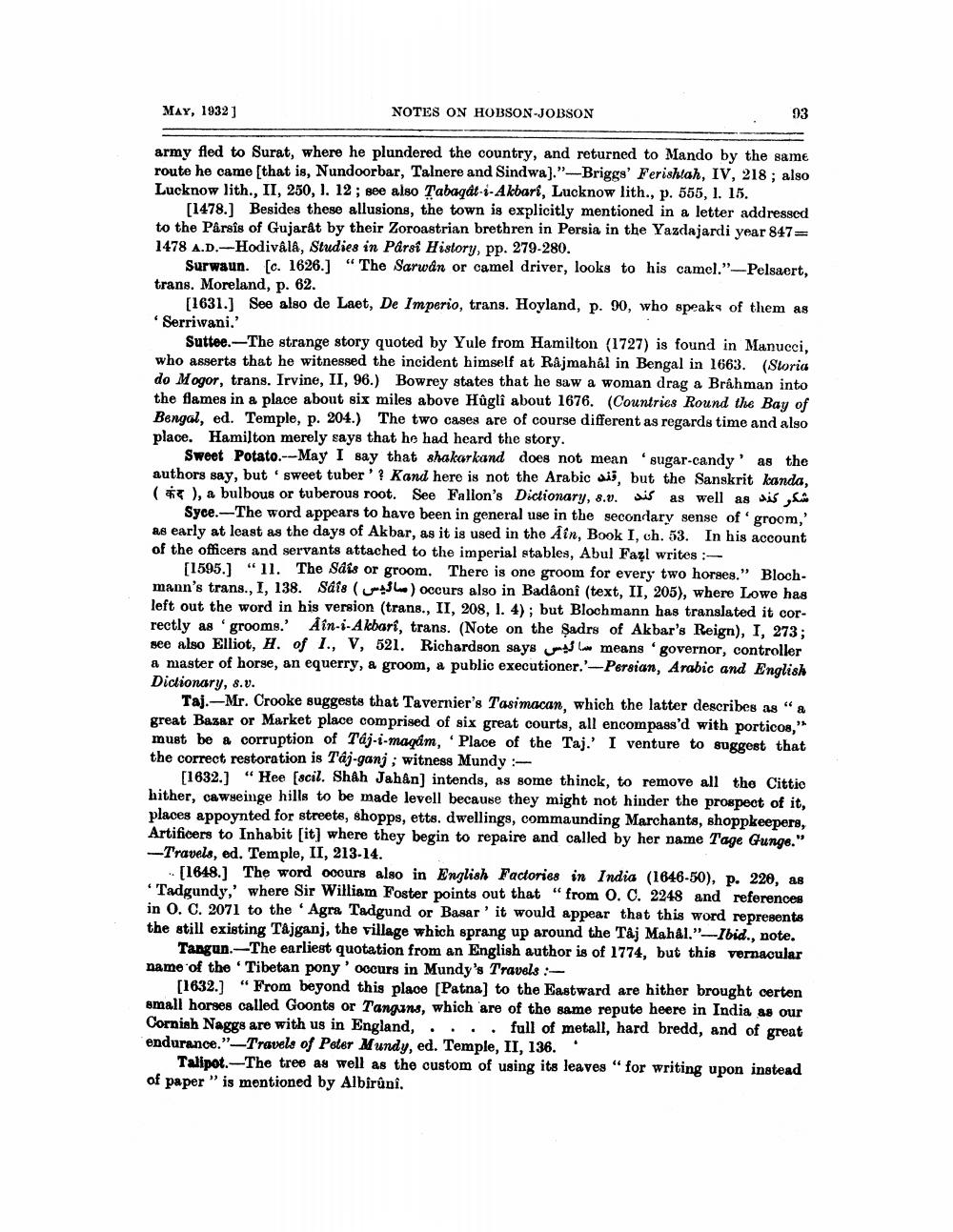________________
MAY, 1932)
NOTES ON HOBSON-JOBSON
93
army fled to Surat, where he plundered the country, and returned to Mando by the same route he came that is, Nundoorbar, Talnere and Sindwa)."-Briggs' Ferishlah, IV, 218; also Lucknow lith., II, 250, 1. 12; see also Tabaqát-s-Akbari, Lucknow lith., p. 555, 1. 15.
11478. Besides these allusions, the town is explicitly mentioned in a letter addressed to the Parsis of Gujarat by their Zoroastrian brethren in Persia in the Yazdajardi year 847= 1478 A.D.--Hodivála, Studies in Pârsi History, pp. 279-280.
Surwaun. [c. 1626.) “The Sarwan or camel driver, looks to his camel."-Pelsaert, trans. Moreland, p. 62.
[1631.) See also de Laet, De Imperio, trans. Hoyland, p. 90, who speaks of them as 'Serriwani.'
Suttee.-The strange story quoted by Yule from Hamilton (1727) is found in Manucci, who asserts that he witnessed the incident himself at Rajmahål in Bengal in 1663. (Storia do Mogor, trans. Irvine, II, 96.) Bowrey states that he saw a woman drag a Brahman into the flames in a place about six miles above Hûglî about 1676. (Countries Round the Bay of Bengal, ed. Temple, p. 204.) The two cases are of course different as regards time and also place. Hamilton merely says that he had heard the story.
Sweet Potato.--May I say that shakarkand does not mean 'sugar-candy' as the authors say, but sweet tuber' Kand here is not the Arabic aii, but the Sanskrit kanda, (# ), a bulbous or tuberous root. See Fallon's Dictionary, 8.v. sis as well as wis Sw
Syce.-The word appears to have been in general use in the secondary sense of 'groom,' as early at least as the days of Akbar, as it is used in the Ain, Book I, ch. 53. In his account of the officers and servants attached to the imperial stables, Abul Fayl writes
[1595.) "11. The Sais or groom. There is one groom for every two horses." Blochmann's trans., I, 138. Saís ( 36) occurs also in Badaoni (text, II, 205), where Lowe has left out the word in his version (trans., II, 208, I. 4); but Blochmann has translated it correctly as groomg.' Ain-s-Akbari, trans. (Note on the Sadrs of Akbar's Reign), I, 273; see also Elliot, H. of I., V, 521. Richardson says a means ' governor, controller a master of horse, an equerry, a groom, a public executioner.' -Persian, Arabic and English Dictionary, 8.v.
Taj. -Mr. Crooke suggests that Tavernier's Tasimacan, which the latter describes as “a great Bazar or Market place comprised of six great courts, all encompass'd with porticos," must be a corruption of T'aj-i-maqdm, Place of the Taj.' I venture to suggest that the correct restoration is Táj-ganj; witness Mundy -
[1632.) “Hee (scil. Shah Jahan) intends, as some thinck, to remove all the Cittie hither, cawyeinge hills to be made levell because they might not hinder the prospect of it, places appoynted for streets, shopps, etts, dwellings, commaunding Marchants, shoppkeepers, Artificers to Inhabit [it] where they begin to repaire and called by her name Tage Gunge." -Travels, ed. Temple, II, 213-14.
11648.] The word ooours also in English Factories in India (1646-50), P. 220. as * Tadgundy,' where Sir William Foster points out that “from 0. C. 2248 and references in 0. C. 2071 to the 'Agra Tadgund or Basar' it would appear that this word represents the still existing Tajganj, the village which sprang up around the Taj Mahal."-Ibid., note.
Tangun.-The earliest quotation from an English author is of 1774, but this vernacular name of the Tibetan pony' occurs in Mundy's Travels
11632.) "From beyond this place [Patna] to the Eastward are hither brought certon small horses called Goonts or Tangans, which are of the same repute heere in India as our Cornish Naggs are with us in England, .... full of metall, hard bredd, and of great endurance."-Travels of Peter Mundy, ed. Temple, II, 136..
Talipot.-The tree as well as the custom of using its leaves " for writing upon instead of paper " is mentioned by Albiruni,




